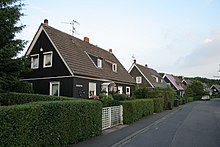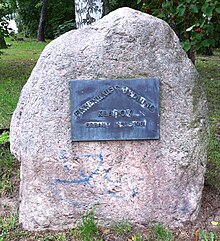Finnhaus Settlement
Finnenhaussiedlung stands for a settlement of prefabricated wooden houses, so-called “Finnhouses”, which were imported from Finland during the Second World War between 1942 and 1944 “for homeless, bomb-damaged families of important military companies” and were mainly built in northern Germany.
history
The delivery was agreed in a treaty between Finland and the German Reich in 1941, at the time the invasion of Russia began . During this time, aircraft attacks on German armaments centers and the dwellings of armaments workers began to increase. The aim of the German authorities was to enable the armaments workers to work in the armaments factories again by replacing housing space.
Places with Finnhaus settlements include Wattenbek , Metzingen (Baden-Württemberg) Flintbek , Bordesholm , Mainz-Gonsenheim , Schönberg (Holstein) and Lübeck-Eichholz as well as Cologne-Höhenhaus ( Finnensiedlung ). In the years 1957/1958, another settlement was built in Berlin-Kladow , which the United States had donated to accommodate political refugees from the Eastern Bloc countries . This and the Finnenhaussiedlung, also built in 1958 in Berlin-Lichterfelde, were construction projects of GEHAG .
Construction
The mostly two-storey building with a gabled roof were as complete kits in panel construction made in Finland and delivered by sea to Germany.
Web links
- Finnenhaussiedlung Berlin-Kladow
- Finnenhaussiedlung Schönberg
- Finnenhaussiedlung Bordesholm (PDF; 6.8 MB)
- Finnish settlement in Lübeck
Individual evidence
- ↑ Volker Plischewsk: Finn houses - questions and answers from a so-called Finn house child . In the yearbook of the Bordesholm History Society, 2009. Ed. History Society in the former Bordesholm Office, 24582 Bruges / Bordesholm. (PDF; 6.8 MB)
- ^ Finnenhaussiedlung Berlin-Lichterfelde; 1958 in the monument database of the Senate Department for Urban Development and the Environment.

